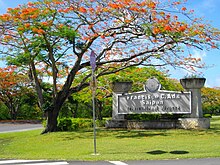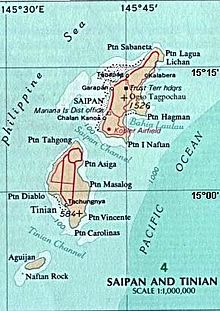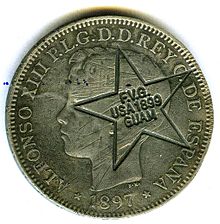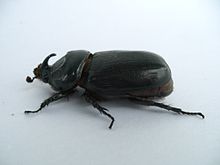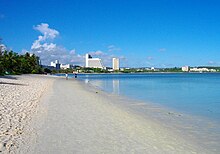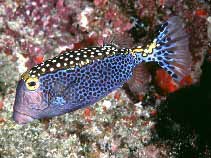Saipan
Topographic map of Saipan Island |
|
 |
|
| Geography | |
|---|---|
| Location | Pacific Ocean |
| Coordinates | 15°10′51″N 145°45′21″E |
| Archipelago | Marianas |
| Area | 44.55 sq mi (115.38 km2) |
| Length | 12 mi (19 km) |
| Width | 5.6 mi (9 km) |
| Highest elevation | 1,560 ft (475 m) |
| Highest point | Mount Tapochau |
| Country | |
|
United States
|
|
| Commonwealth | |
| Demographics | |
| Population | 48,220 (as of 2010) |
| Density | 540.71 /km2 (1,400.43 /sq mi) |
The Commonwealth's center of government is located in the village of Capital Hill on the island. As the entire island is organized as a single municipality, most publications term Saipan as the Commonwealth's capital.
Located at latitude of 15.25° north and longitude of 145.75° east, about 120 mi (190 km) north of Guam, Saipan is about 12 mi (19 km) long and 5.6 mi (9.0 km) wide. It is a popular tourist destination in the Pacific.
The western side of the island is lined with sandy beaches and an offshore coral reef which creates a large lagoon. The eastern shore is composed primarily of rugged rocky cliffs and a reef. Its highest point is a limestone covered mountain called Mount Tapochau at 1,560 ft (480 m). Many people mistakenly believe Mount Tapochau to be an extinct volcano, but it is in fact a limestone formation.[1] To the north of Mount Tapochau towards Banzai Cliff is a ridge of hills. Mount Achugao, situated about 2 miles north, has been interpreted to be a remnant of a stratified composite volcanic cone whose Eocene center was not far north of the present peak.[2]
Besides English, the indigenous Chamorro language is spoken by approximately 19 percent of the inhabitants.[citation needed] The island also has many other large, strongly defined lingual and ethnic groups because of the large percentage of contract workers (60% of total population, as of 2001[3]) from China, Bangladesh, the Philippines, Thailand, Vietnam, and Cambodia. In addition, a large percentage of the island's population includes first-generation immigrants from Japan, China, and Korea, and immigrants from many of the other Micronesian islands.
The current Mayor of Saipan is Republican Donald G. Flores, who was sworn into office on January 11, 2010.[4]
History
Saipan, along with neighboring Guam, Rota/Luta, Tinian, and to a lesser extent smaller islands northward, was first inhabited around 2000 BC.[citation needed] The Spanish were the first Europeans to encounter the Chamorros and Spain eventually annexed Saipan as part of its claim to the Mariana Islands. Around 1815, many Carolinians[5][6] from Satawal settled Saipan during a period when the Chamorros were imprisoned on Guam, which resulted in a significant loss of land and rights for the Chamorro natives. Germany ruled Saipan from 1899 until World War I, when the Empire of Japan took over the island, governing it under a League of Nations mandate from 1922. The Japanese developed both fishing and sugar industries, and in the 1930s garrisoned Saipan heavily, resulting in nearly 30,000 troops on the island by 1941. By December 1941, Saipan had a population of more than 30,000 people, including 25,000 Japanese settlers, many of them from Okinawa.[7]On June 15, 1944 during World War II, the United States Marines and United States Army landed on the beaches of the southwestern side of the island, and spent more than three weeks fighting the Battle of Saipan to secure it from the Japanese. Seabees of the U.S. Navy also landed to participate in construction projects. Japan considered Saipan as part of the last line of defenses for the Japanese homeland, and thus had heavily committed to defending it. Nearly all of the 30,000 Japanese defenders were killed; thousands of Japanese civilians also died, many threw themselves off Banzai Cliff.[8] This history is also interpreted on Saipan at American Memorial Park and the Commonwealth of the Northern Mariana Islands Museum of History and Culture. After the war, nearly all of the surviving Japanese settlers were repatriated to Japan.
The Federal law (the Covenant) making the CNMI a U.S. territory passed in 1975. The CNMI adopted its constitution in 1977, and its first constitutional government took office in 1978.[9] During negotiations, the CNMI and the USA agreed that the CNMI would be exempted from certain federal laws, including some concerning labor and immigration. One result was an increase in hotels and tourism. However, dozens of garment factories also opened; clothing manufacture became the island's chief economic force, employing thousands of foreign contract laborers while labeling their goods "made in the U.S.A." and supplying the U.S. market with low cost garments exempt from U.S. tariffs. The working conditions and treatment experienced by employees in these factories were the subject of controversy and criticism.[10] These factories have all closed down. The CNMI came under Federal minimum wage regulations in 2007 and immigration law in 2008. In June 2009, the U.S. Department of Homeland Security took over the CNMI’s immigration and border controls.
Agriculture, flora and fauna
Saipan's flora is predominantly limestone forest. Some developed areas on the island are covered with Leucaena leucocephala, also known as "tangan-tangan" trees that were introduced some time after World War II. Remaining native forest occurs in small isolated fragments on steep slopes at low elevations and highland conservation areas of the island. Coconuts, papayas, and Thai hot peppers – locally called "Donne Sali" or "Boonie Peppers" – are among the fruits that grow wild. Mango, taro root, and bananas are a few of the many foods cultivated by local families and farmers. Sportfishing has decreased in recent years due to overfishing and is generally considered unacceptably by locals. Historically numerous small boats caught tuna, wahoo, billfish and many other species.[citation needed]Saipan is home to a number of native bird species. Among them: The Mariana fruit dove, White-throated Ground Dove, Bridled White-eye, Golden White-eye, and the endangered Nightingale Reed Warbler.[citation needed]
The island used to have a large population of giant African land snails, introduced either deliberately as a food source, or accidentally by shipping. It became an agricultural pest. In the last few decades, its numbers have been substantially controlled by an introduced flatworm, Platydemus manokwari. Unfortunately, possibly due to the flatworm, the native tree-snails also became extinct.[citation needed]
Music
Music on Saipan can generally be broken down into three categories: local, mainland American and Asian. Local consists of Chamorro, Carolinian, Micronesian and Hawaiian Reggae, called Jawaiian music and song, often with traditional dance for many occasions. Mainland American consists of many of the same varieties that can be found on U.S. radio, and Asian consists of Japanese, Korean, Thai and Philippine music among others. There are seven radio stations on Saipan, which play mainly popular and classic English-language songs as well as local and Philippine music.[11]Television
Local television stations on Saipan are the following:- KPPI-LP (ABC7), the ABC affiliate (repeats KTGM), which is owned by Sorensen Media Group.
- KSPN 2, which is owned by the Flame Tree Network.
- The Visitors Channel 3, which is owned by the Flame Tree Network.
- WSZE-TV 10, the NBC affiliate (repeats KUAM-TV in Guam), which is owned by Pacific Telestations.
Transportation
Travel to and from the island is available from several airlines via Saipan International Airport. A ferry also operates between Saipan and Tinian, its smaller neighboring island 5 miles to the south. Taxis are available.One of the island's two main thoroughfares, Beach Road, is located on the western coast of Saipan. At some parts of the road, the beach is only a few feet away. Flame trees and pine trees line the street. The street also connects more than six villages that lie on the western coast of the island. Middle Road is the island's largest road and runs through its central section. Like Beach Road, Middle Road connects several villages throughout the island. Several offices, shops, hotels, and residences lie on or nearby these highways. Middle road is labeled "Chalan Pale Arnold" on maps, but very few people call it that. As there are no street numbers in Saipan, directions are usually given using landmarks.
Economy
Tourism has long been a vital source of the island's revenue, although the industry has undergone a serious decline since the Asian Economic Crisis of the mid-to-late 1990s. Some major airlines have since ceased regular service to the island. Some internationally-known businesses which located to Saipan are struggling, and some have left.[citation needed]In years past, the main economic driving force in Saipan was garment manufacturing, driven largely by foreign contract workers (mainly from China). As of March 2007,[12] 19 companies manufactured garments on Saipan. In addition to many foreign-owned and run companies, many well-known U.S. brands also operated garment factories in Saipan for much of the last three decades. Brands included Gap (as of 2000 operating six[13] factories there), Levi Strauss,[14] Phillips-Van Heusen,[15] Abercrombie & Fitch,[16] L'Oreal subsidiary Ralph Lauren (Polo),[17] Lord & Taylor,[18] Tommy Hilfiger, and Walmart.[19]
Currently, there are no garment manufacturers on the island, with the last one having closed on January 15, 2009.[20] On November 28, 2009, the federal government took control of immigration to the Northern Mariana Islands.[21]
Villages and towns

Thai hot peppers, or tinian peppers, growing wild.
- Achugao
- As Lito
- As Matuis
- As Perdido
- As Teo
- As Terlaje
- Capital Hill I Denne, Tapochau, and Wireless Ridge
- Chalan Kanoa Laly I, II, III, and IV
- Chalan Kiya
- Chalan Laulau Quartermaster
- Chalan Piao
- Chinatown
- Dandan Airport Road, Naftan, and Obyan
- Fina Sisu
- Garapan
- Gualo Rai
- Kagman I, II, and III"
- Kannat Tabla
- Koblerville As Gonno
- Lower Base
- Marpi
- Navy Hill Chalan Galaide and Rapagao
- Oleai
- Papago
- Sadog Tasi As Mahetog
- San Antonio Afetnas
- San Roque
- San Vicente Lao Lao Beach
- Schultz Village
- Susupe
- Tanapag
Controversy
Jack Abramoff CNMI scandal
Main article: Jack Abramoff CNMI scandal
Jack Abramoff and his law firm were paid at least $6.7 million by the Commonwealth of the Northern Mariana Islands
(CNMI) from 1995—2001 to change or prevent, or both, Congressional
action regarding the Commonwealth of the Northern Mariana Islands (CNMI)
and businesses on Saipan, its capital, commercial center, and one of
its three principal islands.[22]Later lobbying efforts involved mailings from a Ralph Reed marketing company and bribery of Roger Stillwell, a Department of the Interior official who in 2006 pleaded guilty to accepting gifts from Abramoff.[citation needed]
Foreign contract labor abuse and exemptions from U.S. federal regulations
Excerpted from "Immigration and the CNMI: A report of the US Commission on Immigration Reform", January 7, 1998:The Commonwealth of the Northern Mariana Islands (CNMI) immigration system is antithetical to the principles that are at the core of the US immigration policy. Over time, the CNMI has developed an immigration system dominated by the entry of foreign temporary contract workers. These now outnumber US citizens but have few rights within the CNMI and are subject to serious labor and human rights abuses. In contrast to US immigration policy, which admits immigrants for permanent residence and eventual citizenship, the CNMI admits aliens largely as temporary contract workers who are ineligible to gain either US citizenship or civil and social rights within the commonwealth. Only a few countries and no democratic society have immigration policies similar to the CNMI. The closest equivalent is Kuwait. The end result of the CNMI policy is to have a minority population governing and severely limiting the rights of the majority population who are alien in every sense of the word.On March 31, 1998,[23] US Senator Daniel Akaka said:
The Commonwealth shares our American flag, but it does not share the American system of immigration. There is something fundamentally wrong with a CNMI immigration system that issues permits to recruiters, who in turn promise well-paying American jobs to foreigners in exchange for a $6,000 recruitment fee. When the workers arrive in Saipan, they find their recruiter has vanished and there are no jobs in sight. Hundreds of these destitute workers roam the streets of Saipan with little or no chance of employment and no hope of returning to their homeland. The State Department has confirmed that the government of China is an active participant in the CNMI immigration system. There is something fundamentally wrong with an immigration system that allows the government of China to prohibit Chinese workers from exercising political or religious freedom while employed in the United States. Something is fundamentally wrong with a CNMI immigration system that issues entry permits for 12- and 13-year-old girls from the Philippines and other Asian nations, and allows their employers to use them for live sex shows and prostitution. Finally, something is fundamentally wrong when a Chinese construction worker asks if he can sell one of his kidneys for enough money to return to China and escape the deplorable working conditions in the Commonwealth and the immigration system that brought him there. There are voices in the CNMI telling us that the cases of worker abuse we keep hearing about are isolated examples, that the system is improving, and that worker abuse is a thing of the past. These are the same voices that reap the economic benefits of a system of indentured labor that enslaves thousands of foreign workers – a system described in a bi-partisan study as "an unsustainable economic, social and political system that is antithetical to most American values." There is overwhelming evidence that abuse in the CNMI occurs on a grand scale and the problems are far from isolated.In 1991,[24] Levi Strauss & Co. was embarrassed by a scandal involving six subsidiary factories run on Saipan by the Tan Holdings Corporation. It was revealed that Chinese laborers in those factories suffered under what the U.S. Department of Labor called "slavelike" conditions.[citation needed] Cited for sub-minimal wages, seven-day work week schedules with twelve-hour shifts, poor living conditions and other indignities (including the alleged removal of passports and the virtual imprisonment of workers), Tan would eventually pay what was then the largest fines in U.S. labor history, distributing more than $9 million in restitution to some 1200 employees. At the time, Tan factories produced 3% of Levi's jeans with the "Made in the U.S.A." label. Levi Strauss claimed that it had no knowledge of the offenses, severed ties to the Tan family, and instituted labor reforms and inspection practices in its offshore facilities.
In 1999, Sweatshop Watch, Global Exchange, Asian Law Caucus, Unite, and the garment workers themselves filed three separate lawsuits in class-action suits on behalf of roughly 30,000 garment workers in Saipan. The defendants included 27 U.S. retailers and 23 Saipan garment factories. By 2004, they had won a 20 million dollar settlement against all but one of the defendants.[25]
Levi Strauss & Co. was the only successful defendant, winning the case against them in 2004.[25]
In 2005–2006, the issue of immigration and labor practices on Saipan was brought up during the American political scandals of Congressman Tom DeLay and lobbyist Jack Abramoff, who visited the island on numerous occasions. Ms. magazine has followed the issue and published a major expose in their Spring 2006 article "Paradise Lost: Greed, Sex Slavery, Forced Abortion and Right-Wing Moralists".
On February 8, 2007, the United States Senate Committee on Energy and Natural Resources received testimony about federalizing CNMI labor and immigration.
On July 19, 2007,[26] Deputy Assistant Secretary of Insular Affairs David B. Cohen testified before the Senate Committee on Energy and Natural Resources Regarding S. 1634 (The Northern Mariana Islands Covenant Implementation Act).[26] He said:
Congress has the authority to make immigration and naturalization laws applicable to the CNMI. Through the bill that we are discussing today, Congress is proposing to take this legislative step to bring the immigration system of the CNMI under Federal administration. [...] [S]erious problems continue to plague the CNMI's administration of its immigration system, and we remain concerned that the CNMI's rapidly deteriorating fiscal situation may make it even more difficult for the CNMI government to devote the resources necessary to effectively administer its immigration system and to properly investigate and prosecute labor abuse. [...] While we congratulate the CNMI for its recent successful prosecution of a case in which foreign women were pressured into prostitution, human trafficking remains far more prevalent in the CNMI than it is in the rest of the U.S. During the twelve-month period ending on April 30, 2007, 36 female victims of human trafficking were admitted to or otherwise served by Guma' Esperansa, a women’s shelter operated by a Catholic nonprofit organization. All of these victims were in the sex trade. Secretary Kempthorne personally visited the shelter and met with a number of women from the Philippines who were underage when they were trafficked into the CNMI for the sex industry. [...I]t is clear that local control over CNMI immigration has resulted in a human trafficking problem that is proportionally much greater than the problem in the rest of the U.S. A number of foreign nationals have come to the Federal Ombudsman’s office complaining that they were promised a job in the CNMI after paying a recruiter thousands of dollars to come there, only to find, upon arrival in the CNMI, that there was no job. Secretary Kempthorne met personally with a young lady from China who was the victim of such a scam and who was pressured to become a prostitute; she was able to report her situation and obtain help in the Federal Ombudsman’s office. We believe that steps need to be taken to protect women from such terrible predicaments. We are also concerned about recent attempts to smuggle foreign nationals, in particular Chinese nationals, from the CNMI into Guam by boat. A woman was recently sentenced to five years in prison for attempting to smuggle over 30 Chinese nationals from the CNMI into Guam.A movement to federalize labor and immigration in the Northern Marianas Islands began in early 2007. A letter writing campaign to reform CNMI labor and immigration was debated in the local newspapers. Worker groups organized a successful Unity March December 7, 2007. Despite a strong lobby effort by Governor Fitial to stop it, President Bush signed PL 110-229 into law in May 2008 and the US takeover began November 28, 2009.
Contract laborers arriving from China are usually required to pay their (Chinese National) recruitment agents fees equal to a year's total salary[27] (roughly $3,500) and occasionally as high as two years' salary,[23] though the contracts are only one-year contracts, renewable at the employer's discretion.
Sixty percent of the population of the CNMI is contract workers. These workers cannot vote. They are not represented, and can be deported if they lose their jobs. Meanwhile, the minimum wage remains well below that on the U.S. mainland, and abuses of vulnerable workers are commonplace.[3]
In John Bowe's 2007 book Nobodies: Modern American Slave Labor and the Dark Side of the New Global Economy, he provides a focus on Saipan, exploring how its culture, isolation and American ties have made it a favorable environment for exploitative garment manufacturers and corrupt politicos. Bowe goes into detail about the island's factories, and also its karaoke bars and strip joints, some of which have had connections with politicos. The author depicts Saipan as a vulnerable, truly suffering community, where poverty rates have climbed as high as 35 percent, and proposes that the guest worker setup, by allowing many native islanders to avoid work, has actually crippled the competitiveness and job readiness of the native population.
Chinese national, Chun Yu Wang, in her 2009 book, Chicken Feathers and Garlic Skin: Diary of a Chinese Garment Factory Girl on Saipan (as told to Walt F.J. Goodridge), provides the only known first-hand account of factory work conditions and life in the barracks, a historical timeline of the garment factory era on Saipan, and provides revealing insights from a Chinese perspective into the experience typical of many of the garment factory workers on Saipan.
Other local issues
Despite an annual rainfall of 80 to 100 inches (2,000 to 2,500 mm), the Commonwealth Utilities Corporation (CUC), the local government-run water utility company on Saipan, is unable to deliver 24-hour-a-day potable water to its customers in certain areas. As a result, several large hotels use reverse osmosis to produce fresh water for their customers. In addition, many homes and small businesses augment the sporadic and sometimes brackish water provided by CUC with rainwater collected and stored in cisterns. Most locals buy drinking water from water distributors and use tap water only for bathing or washing.Saipan also has a negative place in many Irish people's minds after the “Roy Keane Incident”, a bitter and public falling-out between Republic of Ireland soccer star Roy Keane and Ireland manager Mick McCarthy which took place before the 2002 FIFA World Cup.
Demographics
According to the last census in 2010,[28] the population of Saipan was 48,220.Education
Commonwealth of the Northern Mariana Islands Public School System serves Saipan.Northern Marianas College is a two-year community college serving the Northern Mariana Islands. Also there are many Private Schools on Saipan, such as Marianas Baptist Academy, Saipan International School, Mount Carmel School, Whispering Palms School, Saipan Community School, Grace Christian Academy, and more.
Notable residents from the mainland United States
- Larry Hillblom: 1980s–1995
- Guy Gabaldon: 1926–2006
- William Millard: 1986-2011[29]
Appearances in literature and media
Saipan was a major part of the plot in the Tom Clancy novel Debt of Honor. The island is invaded by Japan, as part of a systematic attack on the United States.The 1960 movie From Hell To Eternity shows the true-life story of Mexican-American (Chicano) GI Guy Gabaldon's role in convincing 800 Japanese soldiers to surrender during the WW 2 Battle of Saipan. A key to Gabaldon's success was his ability to speak Japanese fluently due to being raised in the 1930s by a Japanese-American foster family.
Much of the action in 2002 film Windtalkers takes place during the invasion of Saipan during World War II.
A significant part of the novel Amrita by Japanese author Banana Yoshimoto takes place in Saipan with regular references to the landscape and spirituality of the island.
It also appears in Kyō Kara Ore Wa!! manga as a place that Mitsuhashi visits after winning a lotto.
Saipan is the setting for the P.F. Kluge novel "The Master Blaster". This novel is structured as first person narratives of 5 characters, 4 of whom arrive on the same flight, and the unfolding of their experiences on the island. The book weaves together a mysterious tale of historical fiction with reference to Saipan's multi-ethnic past, from Japanese colonization to American WWII victory and post cold war evolution of the island. The Master Blaster is the home-grown anonymous critic who blogs about the corruption and exploitation by developers, politicians, and government officials.
A new book (2012), by longtime Amelia Earhart researcher and writer Mike Campbell, "AMELIA EARHART: THE TRUTH AT LAST" (Sunbury Press, Camp Hill, Penn.), claims the famous female pilot and her navigator Fred Noonan, who had crash-landed at Mili Atoll, were picked up by a Japanese fishing boat and taken to Kwajalein, and later to Saipan and died on Saipan in Japanese captivity.


